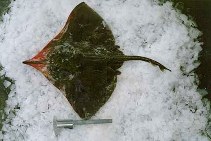| Diagnosis: |
This medium-sized speies of Dipturus (up to at least 118.0 cm TL) is distinguished from its congeners by the following set of characters: when fresh, the dorsal surface of body is plain brownish to greyish, with some lighter small spots randomly distributed dorsally; one red to purple ocellus over center of each pectoral fin; ocelli with well-defined margins, irregular in shape, but often indistinguishable in fixed specimens; ventrally, white to grey with lighter patches over area of gill openings and beneath mouth; area flanking rostral cartilage membranous and slightly translucent and opaque and yellowish when fixed. Further differs by having a relatively broad disc with angular apices, its width 76.4 (75.0; 77.0) % TL; snout relatively short and broad; tail longer in males (42.2 [40.8] % TL) than in female voucher ([38.8] % TL); ventral head length 35.1 (34.2; 37.7) % TL; preorbital snout length 2.4 (2.9; 2.9) times distance between orbits; orbit diameter 0.5 (0.5; 0.6) of inter-orbital width; in males, the dorsal surface of disc and tail with central longitudinal band of dermal denticles extending from anterior margin of rostral cartilage to tail, including anterior margins of dorsal and caudal fins; a thin band of dermal denticles at anterior margins of pectoral fins, extending from anterior fontanelle to front line of alar thorn patches; dorsal surface of disc and tail of females covered with small dermal denticles, except for external margins of pectoral fins, pelvic fins, and area surrounding caudo-central thorns; with orbital thorns; a single nuchal thorn is often absent; both sexes without scapular thorns; a patch of malar thorns only in adult males; alar thorns only in adult males; medial-dorsal and lateral-dorsal thorns may be present in large specimens, especially in large females; small central-caudal thorns mostly arranged in longitudinal pairs in males and females, with two additional longitudinal rows of fine, sharp and posteriorly oriented lateral-caudal thorns may be present in large specimens; ventral sensory pores are small, distinct, black-edged, most abundant on snout and around mouth, scattered over area between gill openings, sparsely spaced on abdominal area and pectoral fins (Ref. 120403). |

